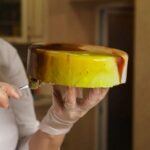Are you looking to elevate your cake decorating skills with a unique and elegant touch? If so, learning how to make chocolate leaves for cake decorating is the perfect way to add a stunning and delicious element to your baked creations. Whether you’re an experienced baker or just starting out, mastering the art of creating chocolate leaves will impress your friends, family, and clients.
In this article, we will explore the step-by-step process of making chocolate leaves for cake decorating. From selecting the right type of chocolate to creating molds from real leaves, we will provide all the information you need to create beautiful and professional-looking chocolate leaves. Additionally, we will share tips on proper technique for pouring and setting chocolate in the leaf molds, as well as handling and storing the finished product.
With our detailed guide, you’ll be able to incorporate chocolate leaves into your cake designs in unique and creative ways. Whether you’re aiming for a rustic and natural look or a more sophisticated and modern style, chocolate leaves are a versatile decoration that can elevate any cake to a work of art. So let’s dive in and discover how to make chocolate leaves for cake decorating like a pro.
Selecting the Right Type of Chocolate for Making Chocolate Leaves
Selecting the right type of chocolate is crucial when making chocolate leaves for cake decorating. For the best results, it is recommended to use high-quality chocolate with a cocoa percentage of at least 70%. This will ensure that the chocolate has a rich flavor and will set properly when creating the leaves.
When choosing the type of chocolate, consider whether you want to use dark, milk, or white chocolate. Dark chocolate is the most commonly used for making chocolate leaves as it has a strong flavor that pairs well with various cake flavors. Milk chocolate can also be used for a sweeter taste, while white chocolate provides a creamy and smooth texture.
In addition to the cocoa percentage and type of chocolate, it’s important to select couverture chocolate, which contains a higher percentage of cocoa butter. This type of chocolate is ideal for making molded chocolates like leaves because it has better fluidity and gloss when melted compared to compound chocolate.
Ultimately, the choice of chocolate comes down to personal preference and the flavor profile you want to achieve in your cake decorating. Experimenting with different types of chocolate can lead to unique and creative designs when using chocolate leaves as part of your cake decorations.
| Type of Chocolate | Best Used For |
|---|---|
| Dark Chocolate (70% cocoa) | Rich and strong flavor; versatile for various cake flavors |
| Milk Chocolate | Sweeter taste; complements desserts with lighter flavors |
| White Chocolate | Creamy texture; adds smoothness to cake decorations |
Step-by-Step Guide to Tempering Chocolate for Perfect Chocolate Leaves
Making chocolate leaves for cake decorating can be a fun and creative way to add an elegant touch to your desserts. One important step in creating these delicate decorations is properly tempering the chocolate. Tempering chocolate involves heating and cooling it in a specific way to ensure a glossy finish and a smooth texture that won’t easily melt at room temperature. Here is a step-by-step guide to tempering chocolate for perfect chocolate leaves:
- Choose the right type of chocolate: Not all chocolates are created equal when it comes to tempering. It’s best to use high-quality chocolate with at least 70% cocoa content for the best results.
- Chop the chocolate: Start by chopping the chocolate into small, uniform pieces. This will help it melt more evenly when you begin the tempering process.
- Melt the chocolate: Use a double boiler or microwave to gently melt the chopped chocolate, stirring frequently to prevent overheating or burning. The goal is to melt the chocolate until it reaches around 115°F (46°C) for dark chocolate, 110°F (43°C) for milk and white chocolates.
- Cool the chocolate: Once melted, pour two-thirds of the melted chocolate onto a marble slab or another cool, clean surface. Use a spatula to spread and agitate the chocolate until it cools down while working continuously until reaching temperatures between 80-82°F (27-28°C) for dark and around 79°F (26°C) for milk and white chocolates
- Reheat the remaining one-third of melted chocolate: Now, add this portion of unmelted reserved good quality tempered table into slightly warm melted original reserve. Stir well until fully mixed together
By following these steps, you can achieve perfectly tempered chocolate that will result in beautiful and professional-looking chocolate leaves for your cake decorating endeavors. Remember that practice makes perfect, so don’t be discouraged if your first few attempts aren’t exactly as you envisioned – just keep experimenting and refining your technique until you achieve your desired results.
Choosing the Best Leaves for Creating Chocolate Molds
When it comes to creating chocolate leaves for cake decorating, the first step is selecting the right type of leaves to use as molds. The best leaves for making chocolate molds are those that are relatively flat and have distinct veins or patterns on the surface. This will help to create a detailed and realistic look for the chocolate leaves once they are set and removed from the molds.
Choosing the Right Leaves
When choosing leaves for creating chocolate molds, it’s important to select fresh, vibrant leaves that are free from any blemishes or tears. Leaves with a smooth texture and well-defined veins work best for this purpose. Commonly used leaves include maple, ivy, and mint, but any leaf with a unique shape or texture can add character to your chocolate decorations.
Preparing the Leaves
Before using the leaves as molds for your chocolate, it’s essential to wash and thoroughly dry them to remove any dirt or debris. This will ensure that your chocolate leaves are not only visually appealing but also safe for consumption. Once clean and dry, the leaves can be used immediately for creating chocolate molds.
Creating Diverse Designs
In addition to traditional single-leaf molds, consider experimenting with different sizes and shapes of leaves to create diverse designs for your cake decorations. You can mix and match various types of leaves to add visual interest and depth to your chocolate leaf motifs on cakes or other desserts.
By carefully selecting and preparing the best leaves for creating chocolate molds, you’ll be on your way towards producing stunning and lifelike chocolate leaves for cake decorating. These beautifully crafted accents will elevate the visual appeal of your confections, impressing both family and friends alike with your attention to detail in every bite.
Creating Chocolate Molds From Real Leaves
One of the most unique and visually appealing ways to create chocolate leaves for cake decorating is by using real leaves as molds. This technique gives the chocolate leaves a realistic and intricate vein pattern that adds a touch of elegance to any cake design. To create chocolate molds from real leaves, it’s important to select the right type of leaf, properly prepare it for molding, and have the patience to allow the chocolate to set.
When selecting leaves for creating chocolate molds, it’s essential to choose ones that are firm and free from any blemishes or tears. The best types of leaves for this purpose are those with a pronounced vein pattern, such as maple or oak leaves. Once you have selected your leaves, gently wash and dry them to remove any dirt or debris. It’s also important to ensure that the leaves are completely dry before proceeding with the molding process.
After washing and drying the leaves, carefully brush on a thin layer of melted chocolate onto the underside of each leaf. Make sure to coat the entire surface evenly, paying special attention to the veins of the leaf.
Then, place the coated side of each leaf onto a piece of parchment paper and allow the chocolate to set at room temperature or in the refrigerator. Once fully hardened, carefully peel away the real leaf from the chocolate mold, leaving behind a beautifully detailed and edible replica.
Using real leaves as molds for creating chocolate leaves can be a simple yet stunning way to elevate your cake decorating skills. The resulting chocolate leaves will not only impress guests with their lifelike appearance but also add an unforgettable aesthetic quality to any cake design.
| Leaf Type | Best Use |
|---|---|
| Maple | For intricate vein patterns |
| Oak | Provides a bold and rustic look |
Proper Technique for Pouring and Setting Chocolate in the Leaf Molds
Creating chocolate leaves for cake decorating requires a proper technique for pouring and setting the chocolate in the leaf molds. Follow these step-by-step instructions to ensure that your chocolate leaves come out perfectly every time:
1. Prepare the chocolate: Begin by tempering the chocolate to ensure a glossy finish and smooth texture. Select high-quality chocolate that is suitable for tempering, such as couverture or tempered dark, milk, or white chocolate.
2. Pouring the chocolate: Once the chocolate is properly tempered, carefully pour it into the leaf molds. Use a spoon or offset spatula to spread the chocolate evenly over the surface of each leaf mold, making sure to fill all of the details and crevices in the leaf shape.
3. Setting the chocolate: Allow the chocolate to set partially at room temperature until it has thickened slightly but is still tacky to the touch. Then, transfer it to the refrigerator to chill completely until it becomes firm.
Properly pouring and setting the chocolate in the leaf molds is crucial for creating beautiful and realistic-looking chocolate leaves for cake decorating. By following these steps, you can ensure that your chocolate leaves turn out perfectly every time.
It’s important to note that mastering this technique may take some practice, so don’t be discouraged if your first few attempts are not perfect. With time and experience, you will be able to create stunning chocolate leaves that will elevate your cake designs to a whole new level.
Removing and Handling the Chocolate Leaves Without Damaging Them
When it comes to using chocolate leaves for cake decorating, it’s essential to master the technique of removing and handling the delicate chocolate leaves without causing any damage. Once the chocolate has set in the leaf molds, it’s crucial to carefully extract the leaves to ensure that they retain their shape and intricate details.
To remove the chocolate leaves from the molds, gently flex the edges of the mold away from the chocolate to release any air pockets. Then, carefully peel back the edges of the leaf mold to slowly release the chocolate leaf. It’s important to be patient and gentle during this process to avoid any breakage or distortion of the chocolate leaves.
Once you have successfully removed the chocolate leaves from their molds, it’s important to handle them with care. Use a small offset spatula or your fingers to carefully lift and maneuver the chocolate leaves as needed. Avoid placing excessive pressure on any specific areas of the leaf, as this could result in cracks or breakage. With a steady hand and careful movements, you can transfer the chocolate leaves onto your cake without damaging them.
With proper removal and handling techniques, you can ensure that your chocolate leaves remain intact and visually stunning as part of your cake decoration. Mastering this skill will elevate your cake designs and impress anyone who sees or tastes your beautifully adorned creations.
Tips for Storing and Using Chocolate Leaves for Cake Decorating
Storing Chocolate Leaves
After creating and using your chocolate leaves for cake decorating, it’s important to store them properly to maintain their shape and quality. Store the chocolate leaves in a cool, dry place, away from direct sunlight and moisture. You can place them in an airtight container with parchment paper between layers to prevent sticking or breakage. If stored properly, chocolate leaves can last for several weeks.
Using Chocolate Leaves for Cake Decorating
When using chocolate leaves to decorate cakes, cupcakes, or other desserts, consider the overall theme and design of the dessert. Chocolate leaves pair well with floral designs and nature-inspired themes. They can be used to create borders around cakes, as accents on cupcakes, or arranged in clusters on top of a cake for a stunning visual effect.
Experimenting With Flavors and Colors
Get creative with your chocolate leaves by experimenting with different flavors and colors. You can add a hint of peppermint extract or orange zest to the melted chocolate before creating the leaf molds for a subtle flavor enhancement.
Additionally, you can use colored cocoa butter or edible food coloring to tint the chocolate for vibrant, colorful leaves that complement your dessert’s color scheme. Playing with different flavors and colors will add depth and visual interest to your cake decorating projects.
Unique Ways to Incorporate Chocolate Leaves Into Cake Designs
Chocolate leaves can be a beautiful and delicious addition to any cake design, adding a touch of elegance and creativity. There are many unique ways to incorporate chocolate leaves into cake designs, from simple accents to more elaborate features that will wow your guests.
One of the most popular ways to use chocolate leaves is by arranging them in a cascading pattern down the side of a tiered cake, creating a stunning visual effect. This can be done with different sizes and shapes of chocolate leaves to add texture and depth to the design.
Another unique way to incorporate chocolate leaves into cake designs is by using them as a border or frame for the entire cake. By carefully arranging the chocolate leaves around the base of the cake, you can create a nature-inspired look that is both elegant and eye-catching.
Additionally, you can also use chocolate leaves as a central focal point on top of the cake, either by placing them in a circular pattern or by creating a beautiful flower-like arrangement with varying shades of chocolate.
For those who want to take their cake decorating skills to the next level, consider using chocolate leaves to create intricate and realistic scenes on top of the cake. For example, you can use different types of chocolate leaves to form trees, vines, or even animals in a woodland-themed design. By combining various sizes and colors of chocolate leaves, you can create a truly breathtaking masterpiece that will leave your guests in awe.
Incorporating chocolate leaves into cake designs allows for endless creativity and customization, making each creation unique and special. Whether you choose to use them as accents or as the focal point of your design, chocolate leaves are sure to impress and delight anyone who sees – or tastes – your masterpiece.
Conclusion and Final Thoughts on Using Chocolate Leaves for Cake Decoration
In conclusion, chocolate leaves can add a beautiful and elegant touch to any cake design. With the right type of chocolate, proper tempering technique, and careful selection of leaves for molds, you can create stunning and realistic chocolate leaves to enhance your cake decorating. It’s important to handle the delicate chocolate leaves with care and store them properly to maintain their quality and appearance.
Additionally, incorporating chocolate leaves into your cake designs opens up endless creative possibilities. Whether you’re creating a simple yet sophisticated look or aiming for a more intricate and detailed design, chocolate leaves can elevate the overall aesthetic of your cakes. From adding a pop of color to providing a natural element, there are various ways to use chocolate leaves as a versatile decoration for cakes.
Overall, mastering the art of making and using chocolate leaves for cake decorating can truly take your creations to the next level. With patience, practice, and attention to detail, you can achieve professional-looking results that will impress both clients and guests. So don’t be afraid to experiment with different techniques and designs when incorporating chocolate leaves into your cake decorating repertoire.
Frequently Asked Questions
How Do You Make Chocolate Leaves for Decorations?
To make chocolate leaves for decorations, start by washing and drying edible leaves such as mint, rose leaves, or lemon leaves. Melt some chocolate and let it cool slightly. Then, carefully brush a thin layer of chocolate onto the back of each leaf and place them on a wax paper-lined tray.
Once the chocolate sets, gently peel off the leaf to reveal a chocolate replica. These chocolate leaves can be used to decorate cakes, desserts, or even as standalone treats.
What Leaves Are Safe to Paint With Chocolate?
It is important to ensure that the leaves you choose to paint with chocolate are safe for consumption. Some commonly used edible leaves for painting with chocolate include mint, strawberry, lemon verbena, or rose leaves.
Before using any leaf for this purpose, it’s crucial to research if it is safe to consume and if it has been treated with any harmful chemicals or pesticides.
How to Make Leaf for Cake?
Making a leaf for cake is a creative way to add natural elements to your dessert. One method is to create a realistic-looking leaf out of fondant or gum paste by shaping and detailing the material until it resembles a natural leaf.
Another option is to paint real edible leaves with melted chocolate and let them harden before using them as cake decorations. No matter which method you choose, adding handcrafted leaves to your cake can bring an elegant and personalized touch to your dessert creation.

Welcome to my blog about home and family. This blog is a place where I will share my thoughts, ideas, and experiences related to these important topics. I am a stay-at-home mom with two young children. I hope you enjoy reading it! and may find some helpful tips and ideas that will make your home and family life even better!





